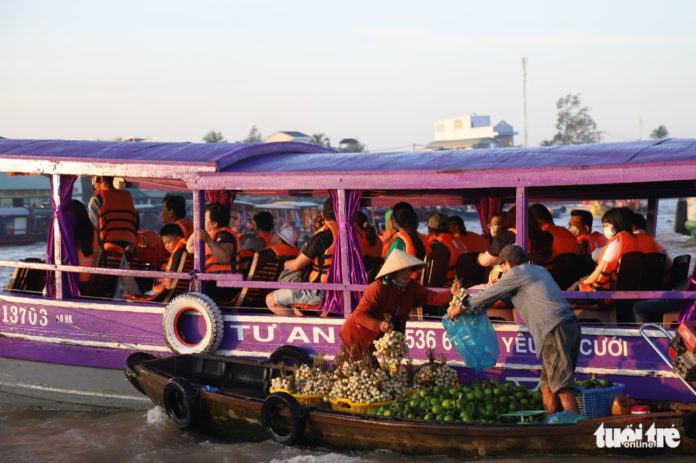In fact, Can Tho City, where Cai Rang is located, already started a project to preserve and develop the floating market.
Although the project has been ongoing for the past five years and many tasks have been completed, there is still a risk that visitors will ignore the floating market.
Monotonous tours
Minh Trung, a visitor, was disappointed after taking a tour to the Cai Rang floating market.
He said he started the tour at Ninh Kieu Wharf, from where the cruise took him first to the boats selling goods, to have breakfast at the floating market, and then to finish the tour altogether.
“They did not take visitors on a tour of the floating market and did not inform us about ‘cay beo,’ the people, and culture in the local community,” Minh Trung said, referring to a long stick that vendors use to hang the goods they want to sell next to their boats.
“In general, I found the tour for tourist products and experiences boring,” Minh Trung said disappointedly.
According to Aunt Bay, who has been selling vermicelli and crab soup at the Cai Rang floating market for 26 years, the number of boats has decreased significantly compared to the most dynamic times in the past.
While there used to be about 20 boats coming from Ca Mau to fetch goods, now there are only two or three, with traders coming from the Mekong Delta provinces of Soc Trang and Bac Lieu.
“Since the Cai Rang floating market has become an attraction, the way goods are bought and sold has changed. This negative competition upsets tourists and discourages many of them from returning,” said Aunt Bay.
Among the complaints about tourism at Cai Rang is that the quality of products and services is not good enough and competition is not healthy.
Besides, the tourism products and experience services are not attractive and there is a lot of garbage floating around the market.
Tran Vu Hung, head of Cai Rang District Economic Bureau, complained that the conservation and development project was not clear enough in terms of assigning detailed tasks, leading to difficulties in implementation for relevant departments and agencies.
“It is assumed that the provincial Department of Culture, Sports, and Tourism is responsible for the preservation of cultural heritage. However, as the floating market is related to trade, the project would fall within the scope of the Department of Industry and Trade’s responsibilities,” Hung said, adding he regretted that the project did not relate to the latter ministry.
For this reason, Can Tho has asked to review the project and renew or revise it if necessary to have a more appropriate model.
It is necessary to keep the sellers
Nguyen Quoc Cuong, chairman of the Cai Rang District People’s Committee, said it is necessary to keep trade in the river stable if the Cai Rang floating market is to survive and develop permanently.
In addition, the floating market should be developed into a wholesale center for agricultural products in the surrounding region.
To this end, local authorities must devise a plan to help vendors collect and sell their products on the river, while supporting them with transportation fees and boat and vessel maintenance costs.
Currently, the Cai Rang People’s Committee approved a project to build a pier for the floating market where vendors can load and unload their goods.
In addition, the projects to build a stopover at the floating market and a floating restaurant are currently in the process of calling for investments.
According to Nguyen Quoc Cuong, Cai Rang District already proposed that the Can Tho People’s Committee assign relevant departments, especially the Department of Culture, Sports, and Tourism, to work with the Department of Industry and Trade to implement the project to maintain and develop the Cai Rang floating market in the near future.
Dao Thi Thanh Thuy, deputy director of the Department of Culture, Sports, and Tourism in Can Tho, said her agency will thoroughly study the project before cooperating with Cai Rang authorities and will eventually submit the final proposal to the municipal People’s Committee.
“The Cai Rang floating market is managed by the district authority, while the department would cooperate with the district in terms of expertise and regulation,” Thuy said.
“So, the possible solution to the problem would be for both sides to participate in the project.
“If one side implements the project and the other does nothing, the floating market could completely ‘sink’ as a result.”
According to cultural researcher and tourism expert Nham Hung, it is necessary to maintain the status quo of the floating market during the process of expanding the area for tourism purposes to keep sellers in the flow.
He advised that the project of preservation and development should be revised soon to eliminate unnecessary structures and have possible solutions for collecting agricultural products in bulk.
Besides, there should be more stopovers to help vendors exchange goods.
Luong Thi Quynh, deputy director of Vietravel Can Tho, suggested from the perspective of a travel agency that there should be tickets to control the number of visitors and cruises to bring guests to the Cai Rang floating market.
There should also be more information points in Ninh Kieu Shipyard for visitors in case they need assistance or want to report something while they are in the area.
Like us on Facebook or follow us on Twitter to get the latest news about Vietnam!




